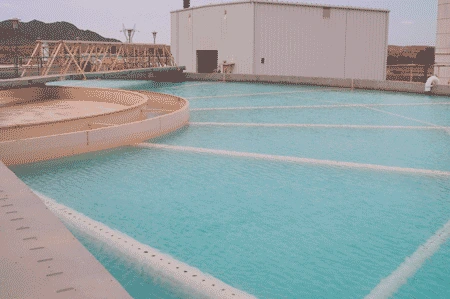Public Policy Review

By all accounts, the Water Resources Research Center’s 2011 conference on Salinity and Desalination in the Southwest was a success. Over the course of the conference, the excellent speakers did a phenomenal job of covering the challenges and opportunities associated with using desalination technology to address pressing water supply challenges in Arizona, the broader region, and worldwide. Holding the conference at the Pivot Point Conference Center on the Colorado River in Yuma allowed us to see restoration efforts and visit the Yuma Desalting Plant. The conference benefitted immensely from our collaboration with the U.S. Bureau of Reclamation.
The pages of this newsletter cover some of the information shared, which included technological, environmental, financial, regulatory, environmental, educational, historical, international, and political perspectives. I am going to summarize some of my take-away messages in the context of the framework presented by Shivaji Deshmukh, Assistant General Manager of the West Basin Municipal Water District, which serves several communities in the Los Angeles area. He underscored the importance of four Es to the incorporation of desalination technology, whether for recycling treated wastewater or desalinating seawater: Energy, Environment, Education, and Economics.
While sound engineering (a fifth E) is a prerequisite to utilization of any technology, engineering itself is not the determinant of our ability to deploy desalination technology. Engineering, as well as research and development, influences the economics or cost of technology. The full costs of technology depend on a host of factors, including the energy used and environmental impacts. The dynamic relationship between energy and water is well recognized, if not always well understood. The type and cost of energy required for desalination are quickly mentioned in discussions of desalination plants. Is the energy carbon-intensive? Does production of the energy itself require a lot of water? The other item quickly mentioned is brine disposal. What happens to the brine stream from the desalination plant? What are the economics and environmental implications of discharging it? Examples discussed at the conference included: conveying it 22 miles to awell site for deep injection, as is done by El Paso Water Utilities; discharging it back into the source water, as is done at seawater plant sites; and transporting it to the Ciénega de Santa Clara, as is done with the Yuma Desalting Plant brine stream.
In addition to the panel addressing the environmental implications of operating the Yuma Desalting Plant, there was considerable mention of environmental implications of desalination. Adriana Rodriguez of the Mexican national water agency CONAGUA, spoke about Mexico’s desalination program. When I asked her about the potential to build a desalination plant in the Sea of Cortez, something that Arizona water entities have studied, she cited concerns about the environment. When discussing the possibility of building a plant at Rosarita, Baja California, she noted the environmental impact of brine discharge. This plant has potential to serve some of San Diego’s needs. While some seem to see the partnership with Mexico as a way for Californians to export the environmental impacts of desalination, I do not see it that way. Mexico is a very sophisticated partner on water matters. Binational arrangements will have to incorporate sufficient benefits for all partners and address environmental impacts. The recently completed test run of the Yuma Desalting Plant provides an example.
Education is a critical piece of the puzzle. Educating policy makers and the public is key to moving forward with long-term investments. We heard about Israel’s desalination strategy, as well as that of Australia, where conditions associated with severe drought spurred action. California’s cutbacks of water deliveries from the State Water Project were a wake-up call to residents of Southern California. We also heard about the efforts of the West Basin Municipal Water District, where the public has accepted investment in high-level treatment of wastewater for use by industry as well as general municipal customers. West Basin has also invested in a sophisticated education center for its customers. Education efforts require resources, too, but the payoff can be great. Teachers from the Yuma area attended part of the conference and participated in a workshop conducted by Arizona Project WET. They heard about the complex considerations and costs associated with desalination and toured the water quality center operated by Reclamation at the YDP site. They will surely take what they learned back to the classroom. The conference, however, was just a very small part of the education efforts that are needed by our communities and the State.
Economic considerations permeate all decision making. Understanding the trade-offs associated with alternative policies is critical. The test run of the Yuma Desalting Plant was a conference focus. Now that it is complete, what will the future of this plant be? Will it return to its dormant status? Will the investment be made in re-piping the plant, something we heard was necessary? Should it be made? When the Bureau of Reclamation’s reports and other analyses, including the results of the environmental studies being led by Karl Flessa of the University of Arizona, are completed, they will serve as the foundation of much discussion. Other discussions will ensue in Arizona regarding desalination of brackish groundwater and treated wastewater. It is important that we consider carefully the economic implications of alternative courses of action.
We have our work cut out for us. As noted by Deputy Reclamation Commissioner Kira Finkler, in her talk at dinner, we are experiencing long-term drought conditions at a time of severe budget limitations at all levels of government. Michael Galbadon of Reclamation likewise underscored the importance of ensuring long-term access to water for all water using sectors. For many, desalination is or will become an important component in making water supply portfolios sustainable and resilient. I thank all those who attended, spoke, sponsored or contributed to the conference in other ways. Thanks for participating in our joint exploration of the challenges and opportunities associated with desalination in the Southwest.

